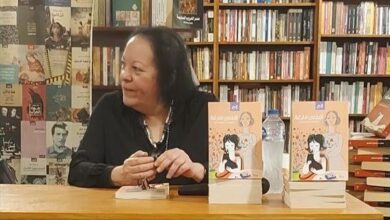In For the Living and the Dead (The American University in Cairo Press, 2010) anthropologist and filmmaker Elizabeth Wickett explores Upper Egyptian funerary laments or idid, in pursuit of a deeper understanding of Egyptian folklore.
Wickett, who has spent 25 years delving into academic research and social development in the Middle East and North Africa, finds that, “lamentation is at the core of social, cultural, and religious customs performed for the dead in Upper Egypt.”
Echoed in the chants of modern-day lamenters is an elaborate history stretching back 5000 years. Through close observation of professional lamenters, Wickett deciphers chants in relation to myth, religion, and ancient Egyptian funerary texts. Evidence of ancient Egyptian lamentation is recorded on tomb walls around the country where paintings depict lamenters in conventional poses on walls, standing, kneeling, or crouched with arms poised overhead. Wickett also inspected ancient Pyramid texts for funerary spells, most of which are reflected in contemporary laments.
But Wickett’s text achieves much more than a mere depiction of surviving funerary laments and the convoluted rapport between life and death; using elaborate diction and sophisticated imagery, the writer provides a unique insight into the intricacies of Upper Egyptian life.
“The performance of funerary laments in contemporary Egypt, a tradition we know to have enclosed in the mainstream of religious practice from the early dynastic era, must now be constructed as a folk tradition, embedded in women’s cultural practice, one that is external to, and has been in constant tension with, the orthodox religions Islam and Coptic Christianity for at least two millennia,” writes Wickett.
Wickett sought to “Honor these Luxor women and invoke national pride in the consummate poetic skills of women who have conserved and embellished their oral tradition.”
Jamal Zaki al-din al-Hajaji, a local folklorist and lover of idid, helped to translate and interpret the local sa’idi dialect, facilitating Wickett’s investigations. Al-Hajaji transcribed lament recordings, which feature Upper Egyptian women chanting words of grief.
Lamentation in Upper Egypt is still linked to a belief in the eternal vitality of the spirit and the soul’s resurrection. Over time, the performance became a social and familial obligation. “The tradition is deeply rooted in women’s cultural mores and beliefs about family well-being, deriving from a mutually beneficial, symbiotic and harmonious relationship of the living to the dead.”
In 1971, in an attempt to discover why women lament, Wickett travelled to Luxor, describing, in diary-like format, her exploration of Upper Egypt’s Gurna, an area which is the “ancient Egyptian domain of the dead, inhabited now by the living.”
A couple of years later, while studying Arabic at Cairo University, Wickett met the famous colloquial Egyptian poet Abdel Rahman al-Abnoudi, who suggested that she studyidid. Her research of the idid began in Kom Lolah, a hamlet in Upper Egypt.
Although it was the poetry and not the morbidity of the lament that enticed the writer, many of the professional lamenters responded to Wickett’s work, which involved reproducing the lamentations, with some skepticism. They feared that their lamenting without a deceased could prove catastrophic.
“Death and the afterlife were not subjects to be toyed with and laments were regarded almost as taboo.” But those who saw the importance of Wickett’s endeavor helped her. Professional lamenters, including Tayha, Zeinab, and Afkar, came to her aid. Tariyya, a widow and professional lamenter, performed idid in exchange for a cup of tea and sugar.
One of her laments, which includes the line “Where is the path that will bring you back again?” brought “arresting” images to Wickett’s mind.
In lamentation, the eye is glorified for allowing grief and catharsis; it is both the source of much-needed tears and the arbiter of fate. Tariyya addresses the eye in preludes to traditional ballads or mawawil.
Wickett also observed the postures of the women while lamenting. “They had wrapped their faces in their diaphanous black veils, pressed their hands to their temples and had rocked slowly from side to side to the pulse of the laments.”
Laments are delivered in couplet form and garnished with improvisation, but have common elements. Each “persona in theidid would seem to be mourned within the familiar constellation of social and kinship roles in Upper Egypt.”
“Each is an abstraction, an archetype that conforms to conventionalized nations of gender roles, social hierarchies and status, with little scope for personalization,” writes Wickett.
The performance of laments stirs feelings of grief in everyone involved. “It is through the reiteration of laments in performance that nostalgic memories of loved ones, lost and mourned, erupt in the hearing and culminate in tears.”
To put the laments in context, Wickett also studied weddings, circumcision songs, and madh (praise for sheikhs and pilgrims to Mecca). Her descriptions of such ceremonies enrich the book and give the reader a deeper insight into the Upper Egyptian society.
Modern laments provide us with strong clues about the performance of the ancient texts, but the tradition has not been passed through generations in written format. Despite its persistence today, lamenting is considered haram (forbidden) in Islam and is condemned by the Coptic Church, although it has never been fully banned. The women who traditionally performed funerary rituals have fallen outside the realm of education and religious instruction; they were not aware of their ancient antecedents. Wickett considers the survival of lamentations to signal the “capacity of human imagination to retain concepts about the fate, mortality of human beings, and cosmos over millennia.”
It also tells us something about the connection between family members, which remain strong even in death. “Funeral mores in Upper Egypt are based on a belief system which perceives the relationship between the dead and the living to be intrinsic to the survival of the family unit.”




